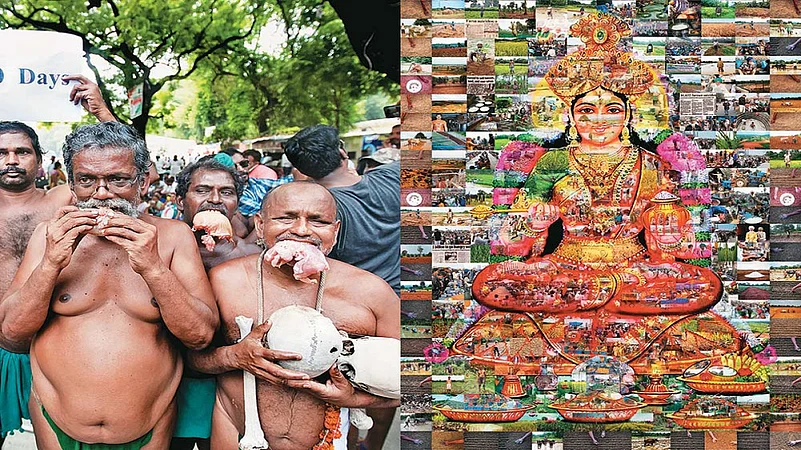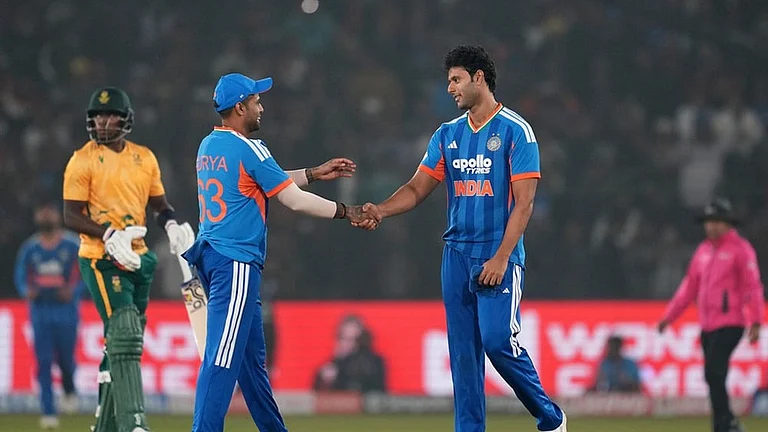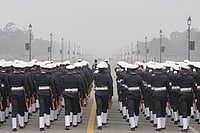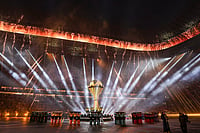On an April afternoon in 2017, nearly 100 men, all farmers from Tamil Nadu, sat in protest at Delhi’s Jantar Mantar. In front of them lay a row of human skulls and from their mouths hung dead rats.
The skulls belonged to fellow farmers who had taken their lives, and the rats, the food they would have been forced to eat if the government did not take cognizance of the drought that they were suffering from in their state.
The farmers were using performance art to register their protest.
In India, protest and art—visual and performance—have had a long-standing, almost symbiotic relationship. Protest inspires art while art enriches a movement by giving it a unique voice.
This protest-art equation can be traced back as early as India’s fight against British rule.
Among the prominent examples would be Abanindranath Tagore’s “Bharat Mata” (1905) that was painted during the Swadeshi movement.
The saffron-clad four-armed image of the Bharat Mata holding a book, sheaves of paddy, a garland and a piece of white cloth was representative of all things Indian, a symbol that continues to be associated with nationalistic emotions even today.
“Most art is political in the sense that it challenges certain accepted norms, protocols. Art definitely stimulates people’s minds to think a little bit more. That itself qualifies to be seen as political,” says performance artist Inder Salim. Protest art per say, he adds, “is where we go in the street…that’s what we can say is performance art… when the body directly participates.”

Like the 2004 nude protest by Manipuri women against the rape and murder of Manorama Thangjam allegedly by Assam Rifles personnel.
The historic protest saw 12 elderly women in the state strip naked outside the Kangla Fort covering themselves with nothing but a sheet of cloth that read, “Indian Army Rape Us”.
In the more recent past, the concept of protest art came to life at the Shaheen Bagh agitation against the Citizenship Amendment Act (CAA), where hundreds of Muslim women, young and old, had staged a sit-in for over four months in Delhi’s biting cold.
ALSO READ: 'Hum Dekhenge': Times When India Protested
The image of a 40-feet map of India built out of iron and mesh, emblazoned with the message: “We the people of Indian reject CAA, NPR and NRC”, became etched in people’s memory, and continues to be associated with the protest even 20 months later.
So have images and paintings, and murals of students standing up to the police, and women reading the preamble.
Less than seven kilometres away, at the NSIC grounds in Okhla, the spirit of Shaheen Bagh reverberated within the temporary white facade of the India Art Fair (2020), where artist Probir Gupta paid a tribute to the women of Shaheen Bagh in a mixed media work titled “Poems of Instruments”.

Artwork by Prabhakar Pachpute
A larger-than-life comb, a hand juicer, a microphone, a typewriter and other protest paraphernalia came together in his work.
On it was inscribed, “Every protest has its foods—foods that become symbols, touch emotions and offer solidarity and succour, forging bonds that go beyond all kinds of divisiveness.”
Art has been an ally of the recent farmers protest as well.
The iconic protest began on November 26 last year with thousands of farmers camping at the Delhi borders—Singhu, Tikri, and Ghazipur—and turning the highways into their homes.
Parveen Kumar, an art teacher in a Ludhiana college, chronicled the movement by recreating the landmark moments on his 24-feet canvas that was displayed at Singhu.
He painted episodes like the farmers breaking barricades at the Haryana border as they faced opposition from the police. Kumar also represented the tussle between the farmers and the government with symbols like a plough toppling over a chair (of power).
The agitation also inspired art outside of the protest sites in the works of renowned artists like Arunkumar HG and Prabhakar Pachpute.

Artwork by Prabhakar Pachpute
Arunkumar who has been addressing agrarian issues through his art for over two decades, created a six-feet tall digital artwork where he has superimposed an image of Hindu god of food and nourishment, Annapurna with “thousands” of photographs of farmers from different agrarian movements from history, including the one against the 2020 farm laws.
“Traditionally, our culture has great respect for farming…it wasn’t just a commodity. I wanted to bring in what we have always had in our consciousness. I wanted to question our imagination of Annapurna,” the Gurgaon-based artist says.
Politics around mining and movements led by farmers over the last several years have been at the core of Pune-based Pachpute’s practice.
A body of his works—sculptures, works on paper, paintings and immersive installations—exhibited in 2020 at Kolkata’s Experimenter gallery, reflected upon the “complex relationships between human, social, economic and political crosscurrents that are at play in the battle for resource, ecology and power”.
“I have been working and observing the issues of coal miners and farmers’ protests all around India over the past 6 to 7 years. Art is a visual language and visuals are impactful. I think visual or performance art has the capability to address these issues,” the artist says.
Art has been playing a key role also in strengthening the voices against Dalit oppression. It is a powerful medium of ethical intervention in unequal and unjust systems, feels artist and curator Prabhakar Kamble.
When the Ambedkar statue in Uttar Pradesh’s Unnao was “vandalised” by painting it saffron in 2018, he protested with a kinetic installation “Disfiguration of Image”, where a sculpture of Ambedkar is being repainted on a loop with saffron paint.
“The fact is that even after 75 years of independence, people are killed in the name of religion and caste. Wherever a system supporting human slavery and exploitation exists, art should be there to intervene. The framework of our Constitution allows us to intervene, and art is a powerful medium for that,” he says.
ALSO READ


























